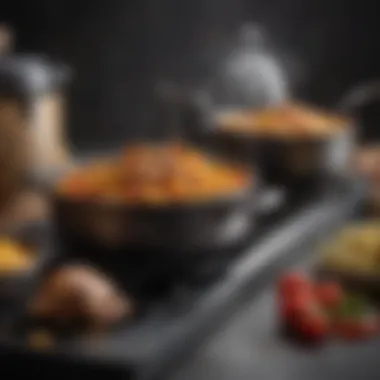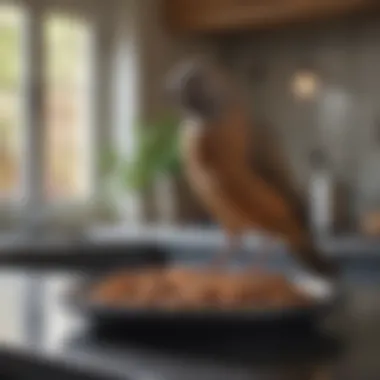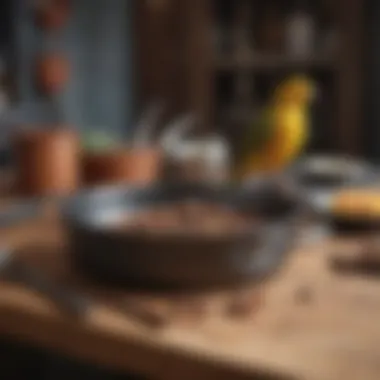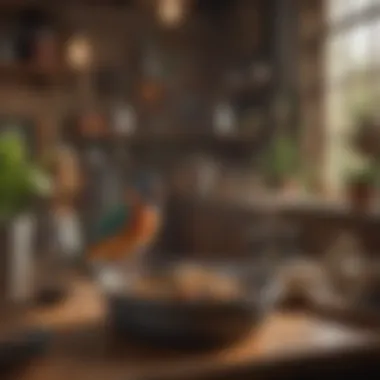Understanding Teflon Pan Dangers for Pet Bird Owners


Intro
As a pet bird owner, ensuring the safety and well-being of your feathery companions is vitally important. This importance extends to the cooking gear you use in your home, particularly Teflon pans. While non-stick cookware has become a staple in many kitchens, it poses significant risks to birds. Understanding these dangers can help bird owners make informed decisions and create a safe living environment for their pets.
In this article, we will explore not only the risks involved with Teflon pans but also the implications for human health and how these pans can affect the overall safety of our feathered friends. We will highlight the chemical nature of Teflon, discuss the potential health hazards for birds and humans alike during the heating process, and present alternative cookware options that provide safer cooking experiences.
Care Tips
Daily Care Routines
Establishing daily care routines is crucial when you have pet birds. This includes maintaining a clean environment, ensuring feeding schedules are consistent, and observing general well-being. Check to ensure that your kitchen is free of overheated Teflon pans daily, as a single incident can have dire consequences for your bird.
Cage Setup and Maintenance
Cage setup and maintenance are vital aspects to consider. A well-organized cage helps your bird feel secure. Ensure that your cage is located in a part of your home where there are no heated Teflon surfaces exposure. It would be best if you distance them from the kitchen area to avoid accidental inhalation of harmful fumes.
Hygiene and Cleaning Practices
Hygiene plays a critical role in the health of your pets. Regularly clean surfaces that your pets frequently interact with, as avoiding contamination can not only keep birds healthy but strengthen the bond you share with them. Use natural cleaners that do not contain any volatile organic compounds or chemicals that might be harmful if ingested or inhaled.
Seasonal Care Adjustments
Seasons change not only the temperature but also the amount of activity birds engage in. During hotter months, be cautious about the appliances used around them, especially with Teflon equipment that can get overheated easily. Seasonal adjustments may also include cleaning practices and potential changes in their diet, depending on the fresh food available during certain times of the year.
Most pet bird fatalities related to Teflon poisoning occur due to overheated nonstick surfaces; knowing this can be lifesaving.
Ending
Understanding the dangers presented by Teflon pans is essential for pet bird owners. By implementing careful care routines and observing safe practices, you can prevent emergencies. Be mindful of your cooking methods, as maintaining their environment directly influences the health and happiness of your birds.
Foreword to Teflon Coated Cookware
Teflon coated cookware is familiar to many. Its non-stick surface claims to make cooking easier and cleanup quicker. This seeming convenience appeals to many home cooks, including those who may not realize the potential risks involving their pet birds. Understanding Teflon is vital as it could directly affect the health and safety of these pets. Therefore, it is crucial for bird owners to consider both the benefits and drawbacks.
History and Popularity of Teflon
Teflon, invented in 1938, gained significant traction as a kitchen staple in the latter part of the 20th century. Initially heralded for its unique non-stick qualities, Teflon captivated the hearts of millions. Thus, it became a common feature in households around the world. Consumers appreciate how it reduces the need for added fats during cooking, making meals healthier, at least superficially.
In addition, manufacturers frequently highlight that Teflon cookware withstands high heat. Such promotion often fuels an assumption of safety during typical usage. Many people consider pairing Teflon with fast cooking methods exciting. However, awareness of potential hazards wasn't at the forefront, especially pertaining to the effects on small animals. Teflon's remarkable popularity keeps these concerns somewhat concealed, although various studies and incidents have shed light on its dangers, especially for susceptible species like birds.
How Teflon Works
Teflon provides a coating made of polytetrafluoroethylene, or PTFE. The chemical structure allows for a smooth, non-stick surface. This property helps ease food release, simplifying both cooking and cleaning. The resilience against heat makes these pans seemingly high-performing in the kitchen. Nonetheless, this perceived functionality must be approached critically by anyone who cooks with Teflon, particularly pet owners.
When overheated, the Teflon coating can emit toxic fumes. Even more concerning, these fumes are hazardous to birds, leading to severe respiratory distress and even death. Bird owners must practice caution while cooking with Teflon. Properly understanding these chemicals informs safer cooking practices, ultimately forming a core aspect of responsible pet ownership.


As Teflon pans become dangerously hot, the risks for pet birds escalate massively. Therefore, knowledge is paramount for ensuring their well-being.
Navigating the choices in cookware goes beyond mere preference. It reflects the responsibility of ensuring a safe environment, especially for those who share a home with birds.
Chemical Composition of Teflon
Understanding the Chemical Composition of Teflon is crucial for pet bird owners. This information sheds light on what exactly these pans are made of, and why specific components can lead to health risks. Knowing the individual chemicals helps pet owners to make informed decisions about their kitchen choices and the subsequent effects on their feathered friends.
What is Polytetrafluoroethylene (PTFE)?
Polytetrafluoroethylene, commonly called PTFE, is a synthetic polymer popularized for its non-stick qualities. It is primarily known for its resistance to heat, chemical reactions, and friction. PTFE is used in various cookware items due to its ability to provide surface properties that prevent food from adhering.
While PTFE offers benefits like easy cleaning, it raises concerns when overheated. When Teflon-coated pans exceed temperatures of about 500 degrees Fahrenheit (260 degrees Celsius), PTFE begins to break down. At this point, it emits fumes that can be lethal, especially to certain animals, including birds. Therefore, understanding PTFE's properties is fundamental to grasping the potential dangers associated with Teflon pans in a home with pet birds.
Perfluorinated Chemicals (PFCs)
Perfluorinated chemicals, or PFCs, encompass a group of chemicals used in the production of Teflon cookware. This category includes various substances designed to provide additional non-stick properties and durability to the surface. While PFCs contribute to the cookware's effectiveness, there are serious consequences related to their use.
Research indicates some PFCs are persistent in the environment and human body. Their half-life can be notably long, raising concerns about bioaccumulation. Existing studies link certain PFCs with various health risks such as hormonal issues and other health problems in both humans and animals.
The level of dangers posed by these substances supports the need for awareness. Bird owners, in particular, must consider their responsibilities regarding safe cooking practices to prevent any risk associated with overheating cookware containing PTFE and PFCs.
The careful selection of cookware is a critical step for maintaining a safe environment for pet birds.
In summary, knowledge of the Chemical Composition of Teflon begins with familiarizing oneself with components like PTFE and PFCs. Understanding these materials enables pet bird owners to evaluate the cookware they use critically, ensuring the safety of their feathered friends.
Health Risks Associated with Teflon
Understanding the health risks associated with Teflon is vital, especially for bird owners. The use of Teflon pans could have concealed dangers that concern both human health and particularly the well-being of pet birds. When Teflon cookware is overheated, it can release fumes toxic to avian pets, potentially causing serious health issues. The risks are not only limited to the birds but extend to humans as well, although the effects might vary. Addressing these risks enables pet bird owners to make informed decisions that promote a healthy household.
Toxic Fumes from Overheating
Teflon, primarily made of polytetrafluoroethylene (PTFE), begins to emit toxic fumes at temperatures above 500 degrees Fahrenheit. These fumes contain chemicals potentially harmful to living beings. The severity of the issue escalates when one considers that many individuals unintentionally expose their cooking equipment to such excessive temperatures. Understanding how overheating occurs is crucial for preventing inadvertent exposure to dangerous gases. Moreover, a significant amount of the cooking population may remain uninformed about these temperature dangers. The inability of Teflon to communicate such risk can lead to deadly situations, particularly for pet birds, who are much more sensitive to these fumes compared to humans.
Adverse Effects on Human Health
While the focus here is primarily on pet birds, it is pertinent to recognize human health risks from Teflon as well. With prolonged and repeated exposure, humans can experience flu-like symptoms leading to respiratory issues, including headaches and nausea. Certain perfluorinated compounds linked to Teflon have been studied extensively and show potential correlations to various health concerns, including liver damage and increased cholesterol levels. Hence, minimizing exposure to Teflon fumes not only benefits birds but also leads to a healthier living environment for all inhabitants.
Potential Risks to Birds
Bird Sensitivity to Fumes
Birds possess unique respiratory systems that can react extremely negatively to toxins in the air. Regarding bird sensitivity to Teflon fumes, it is essential to note their air sacs, designed for efficient air exchange, leave them vulnerable to harmful substances. Both pet birds and wild birds alike may exhibit various symptoms upon encountering Teflon-related fumes. This underscores the significant risks that standard household practices might unwittingly impose on these animal companions. Explaining the risks related to cooking practices is a critical consideration when discussing the welfare of pet birds.
Symptoms of Teflon Toxicity in Birds


The symptoms of Teflon toxicity in birds are notably distinct. Owners should monitor their pets for noticeable signs such as difficulty breathing, lethargy, or sudden behavioral changes. Early detection is vital. Notably, rapid response is crucial for preventing severe consequences from Teflon exposure. Studies suggest that a bird's smaller lung capacity makes them particularly susceptible to toxins, thus emphasizing the necessity of safeguarding their living environment. Observing these symptoms can directly contribute to a birds' recovery by allowing prompt veterinary intervention.
Recognizing the dangers posed by Teflon is essential in creating a safe environment for pet birds.
Identifying Unsafe Cooking Practices
Identifying unsafe cooking practices is crucial for any bird owner. It involves understanding how certain habits and conditions in the kitchen can expose pet birds to dangerous toxins. This topic is especially inportant when cooking with Teflon pans. As discussed previously, overheated non-stick cookware can release harmful fumes. Thus, recognizing these risks is a vital step towards ensuring the safety of beloved feathered companions.
A structured approach to cooking can minimize these dangers. Key elements include monitoring cooking temperatures and ensuring proper kitchen ventilation. Implementing these practices can substantially reduce risks, creating a safer environment for birds and all living beings in the household. Adopting careful cooking practices can also contribute to longer lives for pet birds, finally safeguarding their well-being.
Recognizing Overheating
Recognizing the signs of overheating is essential. Teflon pans become dangerous once they reach temperatures above 500°F (260°C). At such elevated levels, Teflon can decompose, releasing toxic fumes. These fumes can cause sickness in birds and even humans.
Here are common indicators that a pan is overheating:
- Smoke: If you see smoke rising from your pans, stop cooking immediately.
- Unpleasant odors: Any unusual smell that lingers could indicate impending danger.
- Visual changes: Look for any discoloration or change in the non-stick surface.
Additionally, if using multiple pans, be mindful of the cooking order. Avoid putting a pan with Teflon on a high flame too soon. Regulate your cooking process to maintain safety.
Improper Ventilation in the Kitchen
Improper ventilation can exacerbate the dangers associated with Teflon cookware. Birds are highly sensitive to airborne toxins. In any case where Teflon emits release harmful fumes, adequate airflow becomes vital. Keeping windows open and investing in a range hood can drastically help reduce the presence of dangerous chemicals in the kitchen.
Consider these tips to improve kitchen ventilation:
- Always use exhaust fans: Turn them on while cooking. They help expel potentially dangerous fumes.
- Keep windows ajar: Fresh air circulation is important outdoors. Strategically open windows to draw in fresh air and expel contaminants.
- Assess current air quality: Employ air quality monitors if needed to keep a close watch on kitchen conditions.
Effective ventilation methods can protect both humans and birds from harmful fumes. This precaution is not something to overlook but rather an everyday practice to maintain.
Safe Alternatives to Teflon
Transitioning to safe cookware is crucial for pet bird owners. Teflon's risks, especially regarding toxicity to avian pets, make it necessary to explore alternatives. Using different types of cookware can ensure the health and safety of birds while maintaining culinary efficiency. Here we discuss ceramic, stainless steel, cast iron, and glass cookwares.
Ceramic Cookware Options
Ceramic cookware presents one of the safest alternatives for cooking. Unlike Teflon, it is free from harmful chemicals. Many ceramic pots and pans are also non-reactive, meaning they do not leach any harmful substances into food. They are better at distributing heat uniformely, reducing the chances of hotspots that can cause food to char.Spurchasing high-quality ceramic cookware is vital for avoiding those cheaper ones that may degrade over time.
- Benefits of ceramic cookware include:
- Even heating for more consistent cooking outcomes.
- No toxic fumes when heated, thus creating a safer environment for pet birds.
- Easy to clean, reducing maintenance attempts and time needed in the kitchen.
Stainless Steel and Cast Iron
Both stainless steel and cast iron pans are durable alternatives that do not emit toxic fumes when used. Stainless steel is particularly popular due to its resistance to rust and staining. It is also easy to clean and can cook food thoroughly without reacting adversely.


Cast iron pans may require some seasoning, but they offer great heat retention and distribution. They are especially excellent for searing and frying. However, bird owners need to ensure that iron seasoning is used properly to avoid any potential hazard from excess oxidation.
- Considerations for metallic cookware:
- Opt for stainless steel made of high-quality composition.
- For cast iron, choose pre-seasoned vessels to simplify usage.
- Ensure that the cooking space is well-ventilated to avoid additional stress on birds if cookware needs still secure.
Glass Cookware Benefits
Glass cookware is another excellent alternative. It assures freedom from toxic fumes or chemicals that can harm both humans and birds. Since eyewear allows thorough temperature checks, it enables precise visual monitoring while cooking. Glass can be safely used in most useages of heating and reheating.
- Advantages of glass cookware include:
- Versatility across various cooking methods including oven, microwave, and even stovetop settings.
- Non-porous surface, ensuring flavors remain untainted and easily cleaned.
- Ideally suited for food with extended cooking times due to its ability to retain heat efficiently.
Remember to always check for quality safety ratings before making a purchase. Prioritizing well-reviewed cookware higher generally offers assurances of safety and utility, and likely, greater longevity for continued use.
Switching to these safe alternatives allows bird owners to enjoy cooking without the fear of exposing their pets to hazardous fumes. The largest conscious challenge lies in making informed decisions while exploring numerous options on the market.
Best Practices for Bird Owners
When it comes to caring for pet birds, owners must embrace certain guidelines and strategies to create a safe living environment. These practices are especially pertinent given the risks associated with Teflon pans and other similar cookware. Understanding how best to safeguard birds will not only enhance their safety but also bolster overall peace of mind for their caretakers.
Creating a Safe Environment
Creating a safe environment begins with understanding specific threats, including those posed by overheating Teflon cookware. As birds have heightened sensitivities compared to humans, it is essential to limit their exposure to harmful gases released when Teflon pans are heated excessively.
- Remove Teflon Cookware: If you own pet birds, consider replacing Teflon cookware with safer alternatives, such as ceramic or stainless steel. This fundamental action will instantly diminish the chances of toxic fume exposure.
- Ventilation: Ensure that the kitchen is adequately ventilated when cooking. Open windows and use exhaust fans to minimize the concentration of any gas released during cooking. This decision can serve as a buffer against airborne toxins, fostering a healthier space for birds.
- Designated Safeguarding Areas: Create zones in your home where birds thrive, free from any kitchen conversations and potential heat sources. Keeping them in a separate room while cooking is highly recommendend.
- Regular Observations: Monitor your birds constantly for any signs of respiratory distress. Early detection of symptoms such as panting, wheezing, or lethargy can facilitate quicker responses and interventions.
Implementing these changes fosters not just a safe but also an nurturing space for your pet birds. Blocks wuch as these elevate an owner’s observant capability, crucial for recognizing any danger using advice he comming from medical professionals.
Educating Others about Risks
A critically overlooked aspect of bird ownership is the social responsibility that comes with sharing information about potential risks. Explaining these issues to friends, family, or even service workers, can expand safety consciousness into your community.
- Discussing Teflon Dangers: Engaging in dialogues about the hazards linked to Teflon is essential. Be open about how overheating pans can release gases lethal to birds.
- Sharing Alternatives: Inform others about safe alternatives to Teflon. Enlisting other pet owners or aspiring birdkeepers is beneficial. Many alternatives from ceramic to glass come at similar costs, often providing healthier cooking options.
- Utilizing Social Media: Leverage social networks to spread awareness. Facebook groups or forums on Reddit concerning bird care are effective spaces for discussions on this topic. Threading information into everyday chats amplifies the impact of knowledge shared.
Ultimately, best practices for bird owners revolve around providing a nurturing wellness environment for their feathered friends, while prioritizing education in any safe practicing to enclode other members. Not just for the present what safewise matters but for generations too.
Epilogue
In examining the dangers of Teflon pans, it becomes clear that the implications extend beyond mere convenience in cooking. This topic holds considerable significance, especially for individuals who are pet bird owners. Understanding how Teflon operates, its chemical makeup, and the risks associated with its use ensures that bird owners take the necessary precautions to protect their animals. As these pans can release toxic fumes when overheated, the content offers a vital overview that relate to potential hazards.
Summary of Key Points
- Teflon, commonly used in cookware, contains polytetrafluoroethylene (PTFE), which can become hazardous when subjected to high heat.
- The fumes emitted through overheating can be detrimental not only to humans but particularly dangerous for pet birds. Three species of birds—such as parrots and canaries—often exhibit high susceptibility to these fumes due to their sensitive respiratory systems.
- An exploration of safe alternatives to Teflon, including ceramic, stainless steel, cast iron, and glass cookware is critical to bird owners.
- Education on safe cooking practices and promoting a safe environment this remains paramount in protecting pet birds.
Importance of Awareness and Care
The health and safety of birds is a top priority for any responsible bird owner. It is imperative to cultivate an acute awareness of the hazards presented by cooking materials like Teflon. Knowledge translates into powerful preventative measures. When bird owners commit to using safer alternatives and are mindful of cooking practices, they enhance the habitat for their avian companions.
Educating oneself does not end with personal safety, as it is equally important to relay this information to family and friends. By fostering awareness within one's community, it generates a more substantial commitment to creating safer environments for all pet birds. Being informed reinforces a culture of care and maintain a high quality of life for these sensitive creatures.
Therefore, the implications of this topic are multifaceted: a focus on personal responsibility can effect positive changes, benefiting both avian and human health alike.















